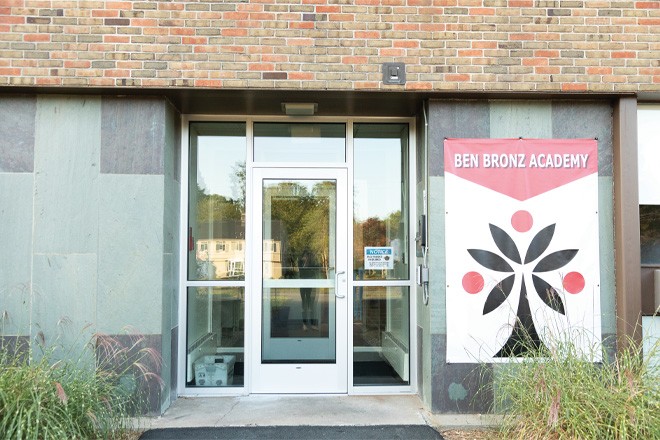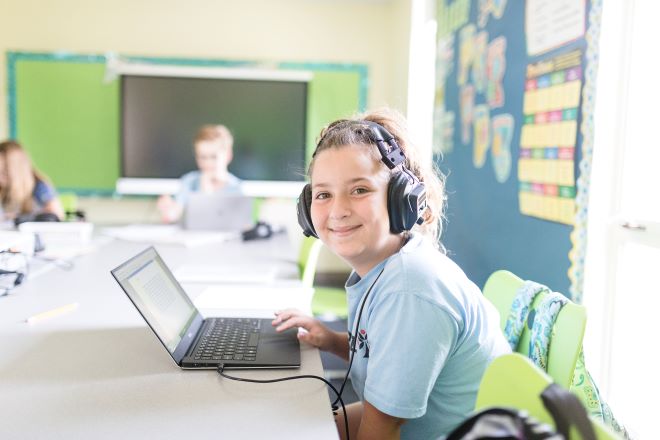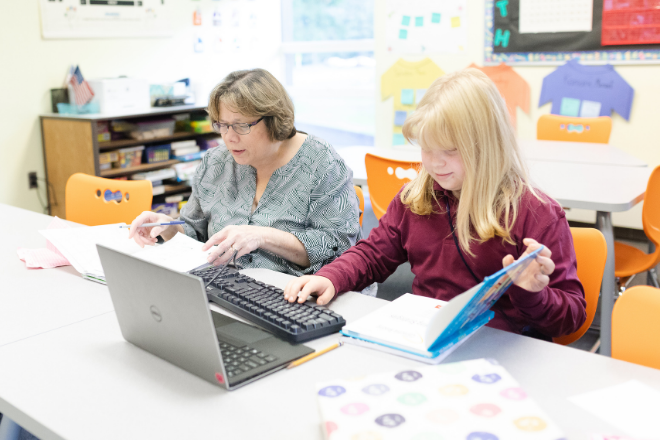Article by Jason Devin, Ben Bronz Academy
Feature image: A student and teacher at Ben Bronz Academy. All photos courtesy of the school.

Ben Bronz Academy
In 2010, Ben Bronz Academy, a small day school for students with learning disabilities, faced an overdue need to upgrade the school’s classroom technology. Approximately 100 student desktops and a dozen teacher notebook computers throughout the school ran on the open source operating system Ubuntu, with the option to boot into Windows XP when necessary. With most of the computer hardware having been donated at different times over the course of several years, inconsistencies troubled the network and made maintenance, deployments and administration extremely cumbersome. Maintaining two systems doubled the school’s IT labor and drained resources. It was also time to consider deploying only as many computers as necessary, not the 100-odd desktops throughout the school.
In 2014, while the administration was assessing the costs and benefits of upgrading the system, a catastrophic data loss occurred, prompting the school leaders to embrace a proactive approach to systems management. Over the next two years, we rapidly replaced stationary desktop computers with portable technology that every student and staff member could use and brought all devices onto a single, well maintained system. All those changes made the pivot to distance learning last spring much easier than it would have been otherwise.
Evaluating IT Requirements
The key questions I asked in evaluating the school’s IT needs were:
- What are the network’s essential functions, in terms of serving school needs?
- What are the network’s biggest challenges that pose barriers to teaching?
- What areas are in need of immediate attention, and are any components obsolete?
- When we make simple improvements in the near-term, will they be sustainable into the long-term?
- Does the school need a major investment in new hardware to meet its goals?
I considered which interventions were aspirational and which were attainable.
Over about a year’s time, I learned to administer the Ubuntu operating system myself to understand its advantages and limitations, and how it interfaces with the specific build of our network. I also became knowledgeable enough to handle server-side issues and subsequently find opportunities for improvement at all levels.

Incremental Change
With the help of an outside IT company, I put together a temporary system using existing hardware to keep us going while I planned for upgrading the entire network. This allowed us to make changes incrementally. Over the next three years, we invested in a few server-side upgrades and a new WiFi network, allowing us to eventually deploy new laptops to all students and staff.
While it was important to determine school technology needs as noted above, it was equally important to build a new system in a manner that met security and data backup requirements.
While it was important to determine school technology needs as noted above, it was equally important to build a new system in a manner that met security and data backup requirements. This point cannot be stressed enough. It may seem terribly inconvenient that a personal device such as an iPhone is not allowed to connect to a networked printer, for example, but printers are easily exploited devices that hackers can use to compromise a network. In the end, this was an opportunity not only to meet the needs of students and teachers, but also to secure the network more fully.
Diverse Needs
In 2015, the school’s founders retired, and our school’s new leadership team began discussing a potential move to a larger facility. As the school grew, an incremental approach to system upgrades would become critical to maintaining operations. And perhaps even more critical was to remain flexible to meet the needs of our community.
Our teachers wanted the opportunity to work from home on progress reports, and we wanted our students to be able to bring laptops not only from class to class but also home, when and if that became a necessity. I also wanted to make sure that we were able to move from our old building to the new one with minimal downtime.
While some elements of the new environment were developed from scratch, such as the new WiFi, bell and phone systems, we wanted to bring staff and students into an environment that felt familiar and consistent. The solution was to migrate all data to an identical server structure in the new location and on new hardware, while operating on a faster, more reliable network.
After becoming the Academy’s chief operating officer in 2017, I hired an accomplished IT assistant, Greg Fraczek, to act as my boots on the ground. We knew that our laptops’ lifespan was about five years, and Greg was tasked with maintaining and repairing them until they were replaced. Planning for obsolesce of hardware was critical.

Questions for a New Era
What none of us could have imagined is that building flexibility into our systems positioned us to go from in-person learning to distance learning over a weekend, in March 2020, as the COVID-19 pandemic took hold in the U.S. Disruptions and delays that might have impacted student progress were minimal.
We are now looking at the next phase of needs with the assumption that distance learning is vital, but with new questions. A basic consideration is the video and sound capabilities of a laptop for distance-learning and distance-teaching. Which laptops have the best noise-canceling options to help reduce those pesky background sounds that require us to remain muted until speaking? Portability is important, but are the services that track and report on a laptop’s location respectful of privacy? Durability was always a primary concern, but how well does the device hold up to frequent disinfecting?
It is crucial to continue providing students and staff with the most flexible and easy-to-use technological tools available that are also adaptable to our ever-changing educational landscape. We must remain prepared to make sudden changes when they arise because, as we have learned, arise they will.



